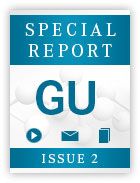Study Illuminates Role of AR-V7 in Carcinogenesis
The role of androgen receptor variant-7 in patients with early stage prostate cancer is not well characterized but data presented at the 2015 American Urological Association Meeting by Tyler M. Bauman, BS, is bringing the discussion into focus.
Tyler M. Bauman, BS
The role of androgen receptor variant-7 (AR-V7) in patients with early stage prostate cancer is not well characterized but data presented at the 2015 American Urological Association (AUA) Meeting by Tyler M. Bauman, BS, is bringing the discussion into focus.
“There is not a lot known about AR-V7, particularly in early stages of prostate cancer,” Bauman, from the Washington University in St. Louis, Missouri, said during his presentation. “It has been studied in castration-resistant disease, but its baseline expression in epithelial and stromal tissue remains unclear.”
Overall, the researchers found that AR-V7 was expressed in both the epithelia and stroma during early stages of prostate cancer development. Additionally, expression of AR-V7 was increased in those with high-grade intraepithelial neoplasia (HGPIN), even in the absence of androgen receptor (AR) expression.
Prostate development and cancer progression have been long known to be dependent upon androgens and AR signaling. AR signaling may play a role in regulating prostate cancer, but prostate tumors can rapidly evolve and develop mechanisms of resistance against targeted agents.
A central mechanism of resistance is persistent activation of the AR, usually achieved through mutations in the ligand-binding domain or in formation of splice variants. These variants occur in about one-third of patients with CRPC. AR-V7 encodes receptors lacking the C-terminal domain, which contains the ligand-binding portion. It has been posited that AR-V7 prostate cancer cell lines have been involved in ligand-independent AR signaling in CRPC.
In the study, researchers used antibodies to detect full length AR and AR-V7 on hormone-naïve tumor-adjacent normal prostate, HGPIN, primary prostate cancer samples, and metastases. Tissue-specific protein expression and co-localization of AR and AR-V7 were measured using multispectral imaging technology. Ratios of AR and AR-V7 were determined.
AR and AR-V7 were present in stromal and epithelial cells in the normal and pathologic specimens. In epithelial tissue, AR-V7 was significantly increased in HGPIN and metastases compared with normal tissue, but not in the prostate cancer tissue. Bauman said expression of AR was increased in prostate cancer tissue and metastases but not HGPIN.
Double-negative cells (AR-/AR-V7-) were lower in HGPIN, prostate cancer, and metastases compared with normal prostate in epithelial tissue. In addition, the proportion of AR-/AR-V7+ was higher in HGPIN and the number of AR+/AR-V7- cells was higher in prostate cancer. Double-positive (AR+/AR-V7+) cells were more abundant in metastases, according to the researchers.
In the stromal tissue specimens, investigators observed that AR-V7 was increased in HGPIN and metastases, but not prostate cancer. The presence of AR was similar in HGPIN and prostate cancer as compared with normal prostate tissue, but higher in metastases.
Video Viewpoint
In stromal specimens, double-negative variants were lower in HGPIN and metastases. Researchers reported that AR-/AR-V7+ was increased in HGPIN and no changes were found in single positive (AR+/AR-V7-) cells.
The proportion of double-positive cells was higher in metastases than normal tissue. The epithelial ratio of AR-V7 to AR was significantly higher in prostate cancer than normal prostate tissue (P= .0003) but not HGPIN (P= .99) or metastases (P= .57). In the stroma specimens, the ratio of AR-V7 to AR was higher in HGPIN (P= .02) but not prostate cancer (P> .99) or metastases (P> .99).
“Overall, our data suggest that AR-V7 has the potential to affect carcinogenesis and androgen independent growth in early stages of prostate cancer development,” said Bauman. “The next step will be creating a cell-line model to look more closely at this in culture, but there’s obviously a lot more to explore on this.”
Bauman TM, Ricke EA, Huang W, et al. Tissue specific expression of androgen receptor variant 7 in prostate cancer progression: a potential role of ARv7 in carcinogenesis. Presented at: 2015 AUA Annual Meeting; May 15-19, 2015; New Orleans, LA. Abstract MP6-10.
<<<

Peers Discuss Role of Pola-R-CHP vs R-CHOP in Newly Diagnosed DLBCL
April 19th 2024During a Case-Based Roundtable® event, Haifaa Abdulhaq, MD discussed with participants whether the POLARIX trial influences their choice to use the pola-R-CHP as opposed to R-CHOP regimen for patients with newly diagnosed diffuse large B-cell lymphoma.
Read More
Powell Reviews Updated IO/TKI Data and AE Management in Endometrial Cancer
April 18th 2024During a Case-Based Roundtable® event, Matthew A. Powell, MD, discussed the case of a patient with advanced endometrial cancer treated with lenvatinib plus pembrolizumab who experienced grade 2 treatment-related hypertension.
Read More
Savona Discusses First-Line JAK Inhibition for Patients With Myelofibrosis at Risk of Anemia
April 17th 2024During a Case-Based Roundtable® event, Michael Savona, MD, and participants discussed the case of a patient with myelofibrosis and moderate anemia receiving JAK inhibitor therapy.
Read More